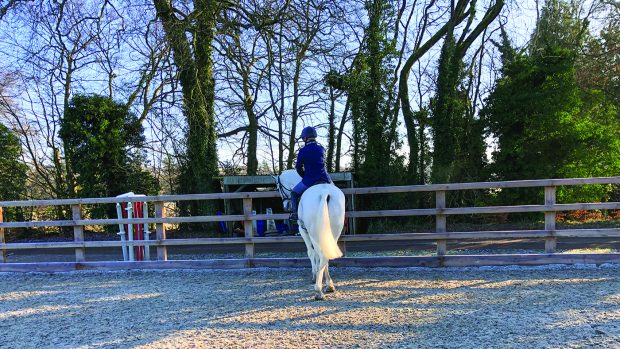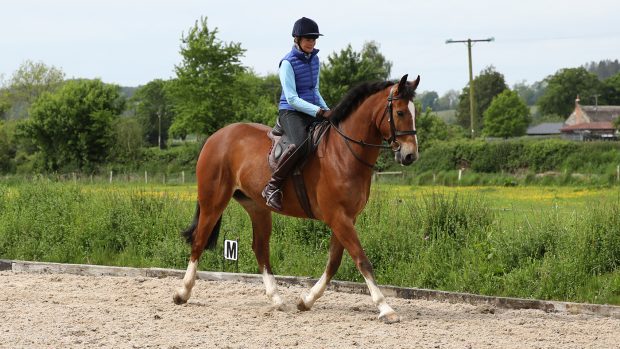It is often the little mistakes that mean riders are giving away marks in dressage tests. H&H asks three dressage judges for their top three mark-losers and pet hates in the arena
Peter Dove
Peter Dove, of East Soley Equestrian Centre, Berkshire, has judged over 15,000 unaffiliated tests and practice judges for BD in preparation for upgrading to a BD listed judge. So passionate is he about helping riders avoid mistakes and improve their dressage scores, he wrote a book, Master Dressage, on this very topic.
Peter’s top three common mistakes are:
- When turning up the centre line, starting too close to the marker, causing the horse to look unbalanced and often overshooting the centre line.
- Poor circle shapes, which cause horses to have non-uniform bend, and corners that make a horse look unbalanced on changes of rein across the diagonals. For example, for FXH the rider starts turning before they get to F (‘winging’ around corner) and then don’t ride to the track at H, which makes the horse look less balanced.
- Poor performance of the ‘give and retake’ — “Riders need to look it up in the rule book as it gives the correct description; there are often a huge range of variations on this.”
Pet hate
Riders performing circles, turns etc with too much inside bend. “They are riding the horse around with them leaning on the outside shoulder, inherently unbalanced believing they have ‘bend’. Many riders have far too much bend for the size of the circle they are performing.”
Alexander Gingell
Suffolk-based former international eventer Alexander Gingell is a List 4 BD judge, and combines judging commitments with training plus running equine supplements business Hack Up with his wife, Jayne.
Alexander’s top three common mistakes are:
- Riders going the wrong way in tests, sometimes more than once. “It’s mainly nerves, with riders focussing so hard on getting the horse to go right, they lose their way. Get a caller if this is happening.”
- Lack of accuracy on circles and loops, which indicate the rider hasn’t measured what a 15m or 5m circle looks like at home. Riding half a 15m loop as closer to half a 20m loop means the next movement (counter canter) is that much harder, affecting your mark for that as well.
- Poor preparation for transitions, so that instead of riding the transition at the marker, the rider begins to ask for it at the marker, making it late.
Pet hate
Riders not seeking that engagement and forward desire from their horse. “I see riders just settling for an average trot or canter, instead of powering forwards and allowing their horse to show himself to the best of his ability.”
Like this? You might also enjoy reading these:
25 signs you’re an incurable dressage diva/divo
23 of the most embarrassing comments we’ve ever seen on a dressage sheet
Steph Cooper
Steph Cooper is a List 1 BD judge, as well as grand prix level dressage rider. Based in Nottinghamshire, Steph is also much in demand as a trainer. She says that while the type of errors vary, making mistakes happens across all levels.
Steph’s top three common mistakes are:
- At prelim and novice level, riders often ride with their reins too long which allows the horse to go in a deeper outline and on the forehand.
- Instead of having their horses balanced and submissive, riders tend to just let them go in medium trot, pushing them on so that they run. “There needs to be a clear difference in frame and stride. It is hard to bring horses back when they are running in medium trot, and this affects the clear transition back to working trot.”
- At higher levels, not creating sufficient engagement and suppleness through the back, for example through the use of half halts, to prepare for lateral work.
Pet hate
Riders letting their frustration and nerves get the better of them when they make a mistake. “They need to remember that there might be another 20 movements to be judged; just because that particular movement got a two or three, doesn’t mean the next one can’t be a seven or eight, for example.” As someone who used to show hunters, Steph is also a stickler for turnout: “Unless you’re riding a native, your horse should be plaited. It creates a good impression right from the moment the judge sees you — and we’re only human, after all!”
Why you won’t want to miss the H&H Festival of Dressage…
The Horse & Hound Festival of Dressage is a three-day unaffiliated competition featuring championship classes from intro to medium level, as well as warm-up and evening freestyle competitions. It is being held at Sheepgate Equestrian, Lincs on 20-22 July. There will be a prize fund of about £1,000 per level, including winners’ rugs and top-quality prizes. And as well as the dressage, competitors are invited to a drinks reception on the Friday, a hog roast on the Saturday and more evening entertainment, giving all the buzz of a stay-away championship. Find out more >>




